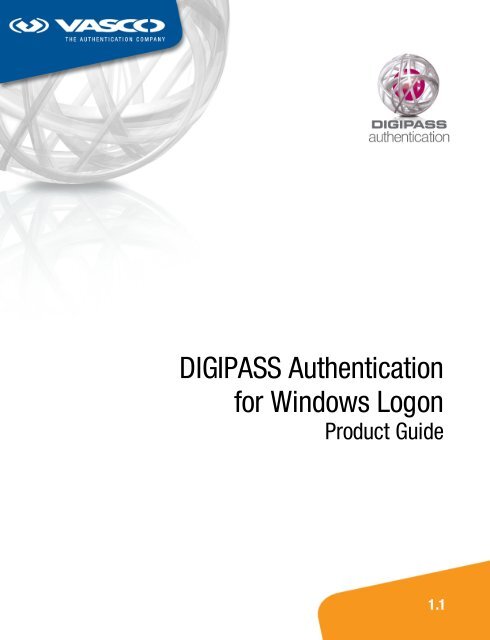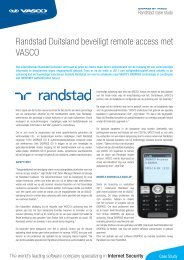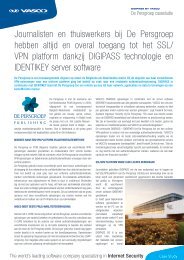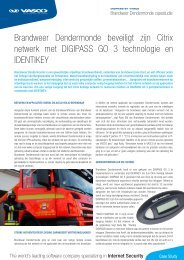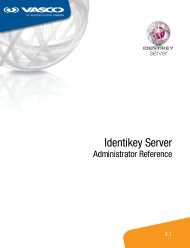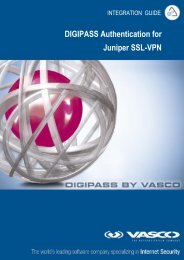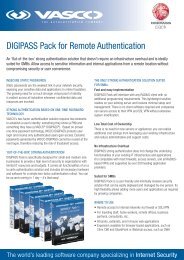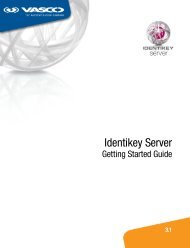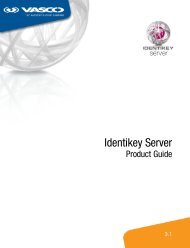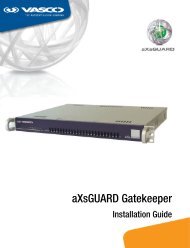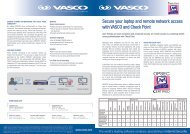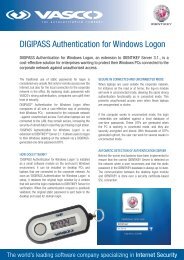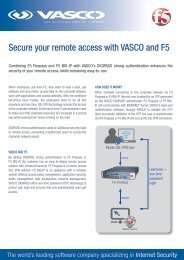DIGIPASS Authentication for Windows Logon - Vasco
DIGIPASS Authentication for Windows Logon - Vasco
DIGIPASS Authentication for Windows Logon - Vasco
You also want an ePaper? Increase the reach of your titles
YUMPU automatically turns print PDFs into web optimized ePapers that Google loves.
<strong>DIGIPASS</strong> <strong>Authentication</strong><br />
<strong>for</strong> <strong>Windows</strong> <strong>Logon</strong><br />
Product Guide<br />
1.1
Disclaimer of Warranties and Limitations of Liabilities<br />
The Product is provided on an 'as is' basis, without any other warranties, or conditions, express or implied,<br />
including but not limited to warranties of merchantable quality, merchantability of fitness <strong>for</strong> a particular<br />
purpose, or those arising by law, statute, usage of trade or course of dealing. The entire risk as to the<br />
results and per<strong>for</strong>mance of the product is assumed by you. Neither we nor our dealers or suppliers shall<br />
have any liability to you or any other person or entity <strong>for</strong> any indirect, incidental, special or consequential<br />
damages whatsoever, including but not limited to loss of revenue or profit, lost or damaged data of other<br />
commercial or economic loss, even if we have been advised of the possibility of such damages or they are<br />
<strong>for</strong>eseeable; or <strong>for</strong> claims by a third party. Our maximum aggregate liability to you, and that of our dealers<br />
and suppliers shall not exceed the amount paid by you <strong>for</strong> the Product. The limitations in this section shall<br />
apply whether or not the alleged breach or default is a breach of a fundamental condition or term, or a<br />
fundamental breach. Some states/countries do not allow the exclusion or limitation or liability <strong>for</strong><br />
consequential or incidental damages so the above limitation may not apply to you.<br />
Copyright<br />
Copyright © 2011 VASCO Data Security, Inc., VASCO Data Security International GmbH. All rights reserved.<br />
No part of this publication may be reproduced, stored in a retrieval system, or transmitted, in any <strong>for</strong>m or by<br />
any means, electronic, mechanical, photocopying, recording, or otherwise, without the prior written<br />
permission of VASCO Data Security Inc.<br />
Trademarks<br />
VASCO®, Vacman®, IDENTIKEY®, aXsGUARD®, <strong>DIGIPASS</strong>®, and ® are registered or unregistered<br />
trademarks of VASCO Data Security, Inc. and/or VASCO Data Security International GmbH in the U.S. and<br />
other countries.<br />
Document Version: 1.9
Table of Contents<br />
Table of Contents<br />
1 Overview........................................................................................................................................................ 4<br />
1.1 <strong>Windows</strong> <strong>Logon</strong> with a <strong>DIGIPASS</strong>......................................................................................................................... 4<br />
1.2 What is a <strong>DIGIPASS</strong>?............................................................................................................................................ 4<br />
1.3 How does <strong>DIGIPASS</strong> <strong>Authentication</strong> <strong>for</strong> <strong>Windows</strong> <strong>Logon</strong> Work?.............................................................................5<br />
1.4 <strong>DIGIPASS</strong> <strong>Authentication</strong> <strong>for</strong> <strong>Windows</strong> <strong>Logon</strong> Components................................................................................... 6<br />
1.5 Available Guides.................................................................................................................................................. 6<br />
2 User <strong>Authentication</strong>........................................................................................................................................ 9<br />
2.1 Online One Time Password <strong>Authentication</strong>........................................................................................................... 9<br />
2.2 Offline One Time Password <strong>Authentication</strong> ........................................................................................................ 10<br />
2.3 Force OTP Use................................................................................................................................................... 12<br />
3 <strong>DIGIPASS</strong> <strong>Authentication</strong> <strong>for</strong> <strong>Windows</strong> <strong>Logon</strong> Features.................................................................................. 13<br />
3.1 Dynamic Component Registration...................................................................................................................... 13<br />
3.2 Static Password................................................................................................................................................. 15<br />
3.3 Static Password Randomization......................................................................................................................... 16<br />
3.4 User Locking..................................................................................................................................................... 18<br />
4 Deployment.................................................................................................................................................. 20<br />
4.1 What Is Needed?............................................................................................................................................... 20<br />
4.2 Server Discovery <strong>for</strong> <strong>DIGIPASS</strong> <strong>Authentication</strong> <strong>for</strong> <strong>Windows</strong> <strong>Logon</strong> Client Configuration...................................... 21<br />
4.3 <strong>DIGIPASS</strong> <strong>Authentication</strong> <strong>for</strong> <strong>Windows</strong> <strong>Logon</strong> Client Registration Configuration................................................... 22<br />
4.4 User Locking Configuration................................................................................................................................ 22<br />
4.5 How to Distribute Client Installation Software..................................................................................................... 23<br />
4.6 <strong>DIGIPASS</strong> Token Assignment.............................................................................................................................. 23<br />
5 <strong>DIGIPASS</strong> <strong>Authentication</strong> <strong>for</strong> <strong>Windows</strong> <strong>Logon</strong> With IDENTIKEY Server on Linux .............................................. 25<br />
6 Licensing...................................................................................................................................................... 26<br />
6.1 Add License <strong>for</strong> <strong>DIGIPASS</strong> <strong>Authentication</strong> <strong>for</strong> <strong>Windows</strong> <strong>Logon</strong>............................................................................. 26<br />
7 Technical Support......................................................................................................................................... 27<br />
7.1 Glossary............................................................................................................................................................ 28<br />
<strong>DIGIPASS</strong> <strong>Authentication</strong> <strong>for</strong> <strong>Windows</strong> <strong>Logon</strong> Product Guide 3
1 Overview<br />
1.1 <strong>Windows</strong> <strong>Logon</strong> with a <strong>DIGIPASS</strong><br />
Overview<br />
<strong>DIGIPASS</strong> <strong>Authentication</strong> <strong>for</strong> <strong>Windows</strong> <strong>Logon</strong> is a product that allows a User to log on to <strong>Windows</strong> using a<br />
<strong>DIGIPASS</strong>.<br />
<strong>DIGIPASS</strong> <strong>Authentication</strong> <strong>for</strong> <strong>Windows</strong> <strong>Logon</strong> integrates seamlessly with the existing <strong>Windows</strong> logon system. The<br />
User ID is entered along with a One Time Password generated by the <strong>DIGIPASS</strong>. The existing <strong>Windows</strong> static<br />
password is released and passed to the <strong>Windows</strong> logon system. The <strong>DIGIPASS</strong> <strong>Authentication</strong> <strong>for</strong> <strong>Windows</strong> <strong>Logon</strong><br />
product securely stores the <strong>Windows</strong> static password using strong encryption.<br />
1.2 What is a <strong>DIGIPASS</strong>?<br />
A <strong>DIGIPASS</strong> <strong>Authentication</strong> <strong>for</strong> <strong>Windows</strong> <strong>Logon</strong> token is a device <strong>for</strong> providing One Time Passwords to a User.<br />
A <strong>DIGIPASS</strong> <strong>Authentication</strong> <strong>for</strong> <strong>Windows</strong> <strong>Logon</strong> token may be provided to each person whom an organization<br />
wishes to be able to log into their system using a One Time Password (OTP). The User obtains an OTP from the<br />
<strong>DIGIPASS</strong> <strong>Authentication</strong> <strong>for</strong> <strong>Windows</strong> <strong>Logon</strong> token to use instead of, or as well as, a static password when logging<br />
in.<br />
For more in<strong>for</strong>mation about <strong>DIGIPASS</strong> <strong>Authentication</strong> <strong>for</strong> <strong>Windows</strong> <strong>Logon</strong>, refer to the <strong>DIGIPASS</strong> section of the<br />
IDENTIKEY Server Product Guide.<br />
<strong>DIGIPASS</strong> <strong>Authentication</strong> <strong>for</strong> <strong>Windows</strong> <strong>Logon</strong> Product Guide 4
1.3 How does <strong>DIGIPASS</strong> <strong>Authentication</strong> <strong>for</strong> <strong>Windows</strong> <strong>Logon</strong> Work?<br />
1.3.1 Components<br />
Image 1: <strong>DIGIPASS</strong> <strong>Authentication</strong> <strong>for</strong> <strong>Windows</strong> <strong>Logon</strong> Overview Architecture<br />
Client PC<br />
The client PC contains the <strong>DIGIPASS</strong> <strong>Authentication</strong> <strong>for</strong> <strong>Windows</strong> <strong>Logon</strong> client module.<br />
<strong>Windows</strong> <strong>Logon</strong> Client<br />
Overview<br />
The <strong>Windows</strong> <strong>Logon</strong> client module collects the authentication credentials entered by the User. It per<strong>for</strong>ms a DNS<br />
lookup to locate the correct IDENTIKEY Server. The <strong>Windows</strong> <strong>Logon</strong> client module delegates OTP validation to<br />
IDENTIKEY Server.<br />
IDENTIKEY Server<br />
During advanced installation, the IDENTIKEY Server automatically registers its location with the DNS Server,<br />
enabling the <strong>Windows</strong> <strong>Logon</strong> client to automatically locate it. The IDENTIKEY Server recieves input from the<br />
<strong>Windows</strong> <strong>Logon</strong> client and processes the authentication request. It sends the authentication request results back to<br />
the client PC.<br />
<strong>DIGIPASS</strong> <strong>Authentication</strong> <strong>for</strong> <strong>Windows</strong> <strong>Logon</strong> Product Guide 5
1.4 <strong>DIGIPASS</strong> <strong>Authentication</strong> <strong>for</strong> <strong>Windows</strong> <strong>Logon</strong> Components<br />
Overview<br />
<strong>DIGIPASS</strong> <strong>Authentication</strong> <strong>for</strong> <strong>Windows</strong> <strong>Logon</strong> consists of Client Components and Server Components. The Client<br />
Components are installed on the Client PC and the Server Components are part of IDENTIKEY Server.<br />
1.4.1 Client Components<br />
The <strong>Windows</strong> <strong>Logon</strong> Client Module is installed on the Client PC.<br />
The Client Module contains:<br />
<strong>Windows</strong> <strong>Logon</strong><br />
Tray Application<br />
For more in<strong>for</strong>mation, refer to the following sections of the <strong>DIGIPASS</strong> <strong>Authentication</strong> <strong>for</strong> <strong>Windows</strong> <strong>Logon</strong> User<br />
Manual:<br />
Understanding DP <strong>Windows</strong> <strong>Logon</strong><br />
Using DP <strong>Windows</strong> <strong>Logon</strong> Tray Agent<br />
1.4.2 Server Components<br />
The <strong>DIGIPASS</strong> <strong>Authentication</strong> <strong>for</strong> <strong>Windows</strong> <strong>Logon</strong> Server components are:<br />
IDENTIKEY Server<br />
Web Administration Interface<br />
Active Directory Users and Computers Extension<br />
Audit Viewer<br />
TCL Command Line Application<br />
Password Synchronization Manager (PSM)<br />
Refer to the Server Components section of the IDENTIKEY Server Product Guide <strong>for</strong> more in<strong>for</strong>mation.<br />
1.4.3 Communication Protocols<br />
All communication between the <strong>DIGIPASS</strong> <strong>Authentication</strong> <strong>for</strong> <strong>Windows</strong> <strong>Logon</strong> and IDENTIKEY Server takes place<br />
using SEAL, over SSL.<br />
1.5 Available Guides<br />
The following <strong>DIGIPASS</strong> <strong>Authentication</strong> <strong>for</strong> <strong>Windows</strong> <strong>Logon</strong> guides are available:<br />
<strong>DIGIPASS</strong> <strong>Authentication</strong> <strong>for</strong> <strong>Windows</strong> <strong>Logon</strong> Product Guide 6
<strong>DIGIPASS</strong> <strong>Authentication</strong> <strong>for</strong> <strong>Windows</strong> <strong>Logon</strong> Product Guide<br />
Overview<br />
The Product Guide will introduce you to the features and concepts of <strong>DIGIPASS</strong> <strong>Authentication</strong> <strong>for</strong> <strong>Windows</strong> <strong>Logon</strong><br />
and the various options you have <strong>for</strong> using it.<br />
<strong>DIGIPASS</strong> <strong>Authentication</strong> <strong>for</strong> <strong>Windows</strong> <strong>Logon</strong> Getting Started Guide<br />
The Getting Started Guide will lead you through a standard setup and testing of key <strong>DIGIPASS</strong> <strong>Authentication</strong> <strong>for</strong><br />
<strong>Windows</strong> <strong>Logon</strong> features.<br />
<strong>DIGIPASS</strong> <strong>Authentication</strong> <strong>for</strong> <strong>Windows</strong> <strong>Logon</strong> User Manual<br />
For users of <strong>DIGIPASS</strong> <strong>Authentication</strong> <strong>for</strong> <strong>Windows</strong> <strong>Logon</strong>.<br />
<strong>DIGIPASS</strong> <strong>Authentication</strong> <strong>for</strong> <strong>Windows</strong> <strong>Logon</strong> Installation Guide<br />
The Installation Guide will help you install and configure <strong>DIGIPASS</strong> <strong>Authentication</strong> <strong>for</strong> <strong>Windows</strong> <strong>Logon</strong> to your<br />
requirements.<br />
1.5.1 IDENTIKEY Server Guides<br />
The following guides are available <strong>for</strong> IDENTIKEY Server:<br />
Product Guide<br />
The Product Guide will introduce the features and concepts of IDENTIKEY Server and the various options you have<br />
<strong>for</strong> using it.<br />
<strong>Windows</strong> Installation Guide<br />
Use this guide when planning and working through an installation of IDENTIKEY Server in a <strong>Windows</strong> environment.<br />
Linux Installation Guide<br />
Use this guide when planning and working through an installation of IDENTIKEY Server in a Linux environment.<br />
Administrator Reference<br />
In-depth in<strong>for</strong>mation required <strong>for</strong> administration of IDENTIKEY Server. This includes references such as data<br />
attribute lists, backup and recovery and utility commands.<br />
Getting Started Guide<br />
The Getting Started Guide will lead you through a standard setup and testing of key IDENTIKEY Server features.<br />
Per<strong>for</strong>mance and Deployment Guide<br />
Contains in<strong>for</strong>mation on common deployment models and per<strong>for</strong>mance statistics.<br />
<strong>DIGIPASS</strong> <strong>Authentication</strong> <strong>for</strong> <strong>Windows</strong> <strong>Logon</strong> Product Guide 7
Help Files<br />
Overview<br />
Context-sensitive help accompanies the Administration Web Interface and <strong>DIGIPASS</strong> Extension <strong>for</strong> Active Directory<br />
Users and Computers.<br />
SDK Programmers Guide<br />
In-depth in<strong>for</strong>mation required to develop using the SDK.<br />
<strong>DIGIPASS</strong> <strong>Authentication</strong> <strong>for</strong> <strong>Windows</strong> <strong>Logon</strong> Product Guide 8
2 User <strong>Authentication</strong><br />
User One Time Password <strong>Authentication</strong> can be per<strong>for</strong>med either online or offline<br />
2.1 Online One Time Password <strong>Authentication</strong><br />
2.1.1 Process<br />
User <strong>Authentication</strong><br />
For Online OTP <strong>Authentication</strong> the client machine is connected to the <strong>Windows</strong> Domain and the <strong>DIGIPASS</strong> OTP is<br />
used to logon to the <strong>Windows</strong> Domain.<br />
Online OTP <strong>Authentication</strong> is perfomed by the IDENTIKEY Server.<br />
Image 2: Online <strong>Authentication</strong> Data Flow<br />
Online <strong>Authentication</strong> begins with the User entering their User ID, Password (optional) and OTP. This passes<br />
through the <strong>Windows</strong> <strong>Logon</strong> client to IDENTIKEY Server. IDENTIKEY Server validates the authentication credentials<br />
and generates an authentication result. This <strong>Authentication</strong> result includes the <strong>Windows</strong> static password which is<br />
used by the <strong>Windows</strong> <strong>Logon</strong> Client to per<strong>for</strong>m a <strong>Windows</strong> domain logon.<br />
<strong>DIGIPASS</strong> <strong>Authentication</strong> <strong>for</strong> <strong>Windows</strong> <strong>Logon</strong> Product Guide 9
User <strong>Authentication</strong><br />
If Offline <strong>Authentication</strong> is enabled, IDENTIKEY Server also passes encrypted offline logon data back to the Client<br />
PC. The encrypted offline logon data is used in Offline <strong>Authentication</strong>. See 2.2 Offline One Time Password<br />
<strong>Authentication</strong> <strong>for</strong> further details about Offline <strong>Authentication</strong>.<br />
2.2 Offline One Time Password <strong>Authentication</strong><br />
With Offline One Time Password <strong>Authentication</strong> the Client machine is not connected to the <strong>Windows</strong> domain, and<br />
the <strong>DIGIPASS</strong> OTP is used to logon to the local client machine. Offline OTP authentication will authenticate a logon<br />
using the <strong>Windows</strong> <strong>Logon</strong> client on the Client PC and encrypted offline logon data. This encrypted logon data is<br />
generated by IDENTIKEY Server during Online <strong>Authentication</strong>.<br />
See 2.1 Online One Time Password <strong>Authentication</strong> <strong>for</strong> further in<strong>for</strong>mation about Online <strong>Authentication</strong>.<br />
<strong>DIGIPASS</strong> <strong>Authentication</strong> <strong>for</strong> <strong>Windows</strong> <strong>Logon</strong> Product Guide 10
2.2.1 Process<br />
Image 3: Offline OTP <strong>Authentication</strong><br />
User <strong>Authentication</strong><br />
Offline OTP <strong>Authentication</strong> begins with the User entering their User ID, optional Password and OTP. These login<br />
credentials pass through the <strong>Windows</strong> <strong>Logon</strong> client module. The <strong>Windows</strong> <strong>Logon</strong> client module per<strong>for</strong>ms the<br />
following checks:<br />
Is Offline <strong>Authentication</strong> Data available <strong>for</strong> the User? Offline <strong>Authentication</strong> Data is generated after a successful<br />
Online <strong>Authentication</strong> when Offline <strong>Authentication</strong> is enabled in the Identikey <strong>Windows</strong> <strong>Logon</strong> policy.<br />
Is the Offline <strong>Authentication</strong> data still valid? Offline <strong>Authentication</strong> Data is valid <strong>for</strong> a limited time <strong>for</strong> time-based<br />
data, or a limited number of logons <strong>for</strong> event-based data. The time or event limit is defined on the <strong>Windows</strong><br />
<strong>Logon</strong> Policy.<br />
Does the OTP validation succeed with the Offline <strong>Authentication</strong> Data?<br />
<strong>DIGIPASS</strong> <strong>Authentication</strong> <strong>for</strong> <strong>Windows</strong> <strong>Logon</strong> Product Guide 11
2.2.2 Disable Offline <strong>Authentication</strong><br />
When Offline <strong>Authentication</strong> is disabled <strong>for</strong> a User, be aware of the following:<br />
2.3 Force OTP Use<br />
User <strong>Authentication</strong><br />
Disabling Offline <strong>Authentication</strong> <strong>for</strong> a User means that IDENTIKEY Server will not send any new Encrypted<br />
Offline <strong>Logon</strong> Data to the client PC<br />
Disabling Offline <strong>Authentication</strong> <strong>for</strong> a User means that the User will still be able to use Offline <strong>Authentication</strong><br />
from the time that it is disabled until the Encrypted Offline <strong>Logon</strong> Data has expired OR until the User per<strong>for</strong>ms<br />
their next Online <strong>Authentication</strong>.<br />
A User may be <strong>for</strong>ced to logon either online or offline using an OTP by utilizing settings in the <strong>Windows</strong> <strong>Logon</strong><br />
Client Module. For details on configuring this, refer to the En<strong>for</strong>cing <strong>DIGIPASS</strong> authentication section of the<br />
<strong>Windows</strong> <strong>Logon</strong> User Manual.<br />
<strong>DIGIPASS</strong> <strong>Authentication</strong> <strong>for</strong> <strong>Windows</strong> <strong>Logon</strong> Product Guide 12
<strong>DIGIPASS</strong> <strong>Authentication</strong> <strong>for</strong> <strong>Windows</strong> <strong>Logon</strong> Features<br />
3 <strong>DIGIPASS</strong> <strong>Authentication</strong> <strong>for</strong> <strong>Windows</strong> <strong>Logon</strong> Features<br />
3.1 Dynamic Component Registration<br />
IDENTIKEY Server requires a client component to be registered <strong>for</strong> each incoming authentication request.<br />
Note<br />
Only English ASCII characters are supported <strong>for</strong> computer names.<br />
Names containing non-ASCII characters, such as Japanese or Chinese, are not supported with<br />
Dynamic Component Registration,<br />
Ensure that computer names contain ONLY English ASCII characters.<br />
When Dynamic Component Registration (DCR) is enabled in the Identikey <strong>Windows</strong> <strong>Logon</strong> policy, IDENTIKEY<br />
Server will dynamically create a client component if no client component is found. The registration method<br />
depends on the <strong>Windows</strong> Group Check set in the policy.<br />
<strong>DIGIPASS</strong> <strong>Authentication</strong> <strong>for</strong> <strong>Windows</strong> <strong>Logon</strong> Product Guide 13
Image 4: DCR Registration<br />
The <strong>Windows</strong> <strong>Logon</strong> client component is identified by the following <strong>for</strong>mats:<br />
<strong>DIGIPASS</strong> <strong>Authentication</strong> <strong>for</strong> <strong>Windows</strong> <strong>Logon</strong> Features<br />
Client machine hostname - If DNS based reverse lookup of an IP address is being used with the DNS suffix not<br />
set on the client machine.<br />
Fully qualified domain name (FQDN) - If DNS based reverse lookup of an IP address is being used with the DNS<br />
suffix set.<br />
Note<br />
Dynamic Component Registration will fail if a PTR record does not exist on the DNS server <strong>for</strong> the<br />
client machine. A reverse zone must be implemented in order <strong>for</strong> DCR to function correctly.<br />
<strong>DIGIPASS</strong> <strong>Authentication</strong> <strong>for</strong> <strong>Windows</strong> <strong>Logon</strong> Product Guide 14
3.1.1 Group Check<br />
<strong>DIGIPASS</strong> <strong>Authentication</strong> <strong>for</strong> <strong>Windows</strong> <strong>Logon</strong> Features<br />
To enable Group Check to work correctly in Dynamic Component Registration, the server must be able to reach the<br />
client machine. Refer to 4.2.1Hostname<br />
Resolution . Also ensure that:<br />
3.2 Static Password<br />
The groups named are in the Active Directory domain. Group Check works with Active Directory domain groups<br />
only. It will not work with local <strong>Windows</strong> groups.<br />
The group <strong>for</strong> a client must be defined in the domain that the client will be logging in to. For example, in a<br />
parent/child domain setup, if a client is to be used to log in to the child domain, the group must be defined in<br />
the child domain.<br />
The <strong>DIGIPASS</strong> <strong>Authentication</strong> <strong>for</strong> <strong>Windows</strong> <strong>Logon</strong> relies on the <strong>Windows</strong> static password to per<strong>for</strong>m the <strong>Windows</strong><br />
logon. It is there<strong>for</strong>e important that IDENTIKEY Server is always up to date with the current <strong>Windows</strong> static<br />
password <strong>for</strong> each user. There are two ways to ensure that the static password is up to date:<br />
Static Password Synchronization<br />
Static Password Randomization<br />
3.2.1 Static Password Synchronization<br />
Password Synchronization Manager (PSM) is a product that is installed on the Active Directory domain controller<br />
which allows a change of the <strong>Windows</strong> password to be automatically updated on IDENTIKEY Server. The new<br />
<strong>Windows</strong> password will be reflected as the static password on IDENTIKEY Server.<br />
If IDENTIKEY Server is not available the synchronization will fail.<br />
If the User is not defined on IDENTIKEY Server, only the password on the Domain Controller will be changed.<br />
<strong>DIGIPASS</strong> <strong>Authentication</strong> <strong>for</strong> <strong>Windows</strong> <strong>Logon</strong> Product Guide 15
Image 5: Password Synchronization Overview<br />
3.3 Static Password Randomization<br />
3.3.1 Overview<br />
<strong>DIGIPASS</strong> <strong>Authentication</strong> <strong>for</strong> <strong>Windows</strong> <strong>Logon</strong> Features<br />
Static Password Randomization means that the User's <strong>Windows</strong> static password is replaced by a randomly<br />
generated password during logon. The User only enters their User ID and the OTP, and the password is generated<br />
in the background.<br />
By randomizing the static password, the User is prevented from logging in to <strong>Windows</strong> on a machine which does<br />
not have the <strong>DIGIPASS</strong> <strong>Authentication</strong> <strong>for</strong> <strong>Windows</strong> <strong>Logon</strong> installed as the User is unable to enter a correct random<br />
password.<br />
Static Password Randomization is enabled on the Identikey <strong>Windows</strong> <strong>Logon</strong> policy that is being used.<br />
<strong>DIGIPASS</strong> <strong>Authentication</strong> <strong>for</strong> <strong>Windows</strong> <strong>Logon</strong> Product Guide 16
<strong>DIGIPASS</strong> <strong>Authentication</strong> <strong>for</strong> <strong>Windows</strong> <strong>Logon</strong> Features<br />
Static Password Randomization is only available when <strong>Windows</strong> Back-End <strong>Authentication</strong>, or Active Directory Back-<br />
End <strong>Authentication</strong> is enabled. Static Password Randomization is not available <strong>for</strong> ADAM, Tivoli, or Novell e-<br />
Directory Back-End <strong>Authentication</strong>.<br />
3.3.2 Password Format<br />
3.3.3 Use<br />
The <strong>for</strong>mat <strong>for</strong> the new password will meet the following criteria:<br />
Password length – default length is 16 characters, but default may be overridden by specifying a password<br />
length on the Identikey <strong>Windows</strong> <strong>Logon</strong> policy<br />
Character set – the random password will consist of the following character set:<br />
a to z<br />
A to Z<br />
0 to 9<br />
printable symbols - !@#%^&*()'”+=-_[]\|/?<br />
Complexity requirements:<br />
The random password must not contain the User's User ID or parts of the User's full name that exceed two<br />
consecutive characters.<br />
The random password must contain characters from three of the four character set components listed<br />
above.<br />
The password complexity requirements are taken from the Microsoft <strong>Windows</strong> 2003 Active Directory password<br />
requirements and guarantee a successful <strong>Windows</strong> static password.<br />
Static Password Randomization is used to en<strong>for</strong>ce the use of strong authentication on <strong>Windows</strong> <strong>Logon</strong>. This may<br />
be <strong>for</strong> the following reasons:<br />
The User will not be able to log on to a <strong>Windows</strong> machine without using an OTP.<br />
The User cannot uninstall the <strong>DIGIPASS</strong> <strong>Authentication</strong> <strong>for</strong> <strong>Windows</strong> <strong>Logon</strong> and log on using the <strong>Windows</strong><br />
Static Password only.<br />
Regulatory Compliance. Some regulations specify that a strong password must be defined <strong>for</strong> <strong>Windows</strong> <strong>Logon</strong>.<br />
The regulations frequently relate to the length of the password, combination of characters in the password, and<br />
the frequency with which it must be changed. By using Static Password Randomization better control can be<br />
exerted over the regulatory criteria. Generated random passwords can be longer and much more complex than<br />
a static password that a User has to remember.<br />
<strong>DIGIPASS</strong> <strong>Authentication</strong> <strong>for</strong> <strong>Windows</strong> <strong>Logon</strong> Product Guide 17
Note<br />
3.4 User Locking<br />
<strong>DIGIPASS</strong> <strong>Authentication</strong> <strong>for</strong> <strong>Windows</strong> <strong>Logon</strong> Features<br />
When using Active Directory, a Minimum Password Age is set in Active Directory Group Policy<br />
Management. If the static password is reset on Active Directory Users and Computers Extension<br />
and Password Randomization is enabled on IDENTIKEY Server, the 'User must change password<br />
at next logon' checkbox must be checked. This will avoid authentication failure at the next login<br />
due to the password being too young.<br />
<strong>Authentication</strong>s can fail <strong>for</strong> a number of reasons. The most obvious is that the User does not have authority to use<br />
the product they are trying to authenticate themselves with.<br />
Use of incorrect User Ids, passwords, OTPs, or <strong>DIGIPASS</strong>, will result in <strong>Authentication</strong> failing, and the offending<br />
User Account being locked.<br />
3.4.1 Online <strong>Authentication</strong><br />
The number of unsuccessful Online <strong>Authentication</strong>s is limited according to the limit values set on the Identikey<br />
<strong>Windows</strong> <strong>Logon</strong> policy. If the number of authentications goes beyond that specified, the User will be locked.<br />
3.4.2 Offline <strong>Authentication</strong><br />
3.4.3 Unlock<br />
The number of unsuccessful Offline <strong>Authentication</strong>s is limited, and can be set using Active Directory group policies<br />
or using a local registry setting. If the number of authentications goes above that specified in the Active Directory<br />
group policy the User will be locked.<br />
An error message will appear when a User account has been locked. Follow the instructions in the table below to<br />
unlcock the appropriate account in the appropriate location:<br />
<strong>DIGIPASS</strong> <strong>Authentication</strong> <strong>for</strong> <strong>Windows</strong> <strong>Logon</strong> Product Guide 18
<strong>DIGIPASS</strong> <strong>Authentication</strong> <strong>for</strong> <strong>Windows</strong> <strong>Logon</strong> Features<br />
Error Message What To Do<br />
No Offline <strong>Authentication</strong> Data Clear offline authenticaiton data (AD or Web Administration Interface)<br />
Check <strong>DIGIPASS</strong> User Account and unlock if necessary<br />
User log on and per<strong>for</strong>m online authenticaion. This will renew the<br />
offline authentication data.<br />
Back-End <strong>Authentication</strong> failed Check <strong>Windows</strong> Account and unlock if necessary<br />
If unlocking doesn't work, reset password in <strong>Windows</strong> and IDENTIKEY<br />
Server<br />
<strong>DIGIPASS</strong> account locked Unlock <strong>DIGIPASS</strong> User Account<br />
A User must be unlocked by an administrator using the Users tab of the Web Administration Interface or Active<br />
Directory Users and Computers Extension.<br />
<strong>DIGIPASS</strong> <strong>Authentication</strong> <strong>for</strong> <strong>Windows</strong> <strong>Logon</strong> Product Guide 19
4 Deployment<br />
Note<br />
4.1 What Is Needed?<br />
For any of the following functionality to work, each IDENTIKEY Server must be updated to<br />
IDENTIKEY Server 3.1 SR1 or higher.<br />
Client Module installed on each <strong>Windows</strong> machine<br />
Valid license on IDENTIKEY Server(s) to which client machines will be connecting.<br />
4.1.1 IDENTIKEY Server Ports<br />
4.1.2 Client Ports<br />
During deployment of IDENTIKEY Server the following ports should be made available:<br />
SEAL (SSL) - TCP 20004<br />
SEAL (non-SSL) - TCP 20003<br />
MDC Server - TCP 20007<br />
Live audit - TCP 20006<br />
SOAP - TCP 8888<br />
RADIUS Auth - UDP 1812<br />
RADIUS Auth - UDP 1813<br />
Deployment<br />
Failure to make these ports available to the installer may lead to problems during deployment and configuration.<br />
The following port must be available on the <strong>DIGIPASS</strong> <strong>Authentication</strong> <strong>for</strong> <strong>Windows</strong> <strong>Logon</strong> Client:<br />
4.1.3 DNS Registration<br />
<strong>Windows</strong> Group Check - TCP 445<br />
All IDENTIKEY Servers should be registered with the DNS server(s). This allows Server Discovery, if enabled, to<br />
work correctly.<br />
<strong>DIGIPASS</strong> <strong>Authentication</strong> <strong>for</strong> <strong>Windows</strong> <strong>Logon</strong> Product Guide 20
4.2 Server Discovery <strong>for</strong> <strong>DIGIPASS</strong> <strong>Authentication</strong> <strong>for</strong> <strong>Windows</strong> <strong>Logon</strong> Client<br />
Configuration<br />
Deployment<br />
Server Discovery is used by the <strong>DIGIPASS</strong> <strong>Authentication</strong> <strong>for</strong> <strong>Windows</strong> <strong>Logon</strong> client module to identify the location<br />
of the IDENTIKEY Server to be used <strong>for</strong> authentication.<br />
Server Discovery is configured using the Web Administration Interface ->System Configuration ->Server<br />
Discovery tab, or the IDENTIKEY Server Configuration application. For more in<strong>for</strong>mation about configuring the<br />
server discovery option, refer to the How to Set Up IDENTIKEY Server Discovery section of the IDENTIKEY Server<br />
Administrator Guide.<br />
4.2.1 Hostname Resolution<br />
When Dynamic Client Registration or Server Discovery is being used, the following process is followed to identify<br />
the server required:<br />
1. The client checks to see if the name queried is its own.<br />
2. The client then searches a local Hosts file.<br />
3. DNS servers are queried.<br />
If the above methods fail then NetBIOS name resolution sequence is used as a backup<br />
To aid successful <strong>Windows</strong> <strong>Logon</strong> client authentication use one of the following methods:<br />
1. Statically add Hosts to the c:\windows\system32\drivers\etc\hosts file<br />
2. Setup reverse lookup <strong>for</strong> the network the client belongs to. Entries <strong>for</strong> the IP address of the clients should<br />
already be present. Use nslookup to resolve to the hostname of the client<br />
3. Enable the NETBIOS Name Service Discovery port(UDP Port 137).<br />
In <strong>Windows</strong> 7, if the firewall is turned on (recommended settings), this port is blocked. To enable this port,<br />
Turn on Network Discovery using Network Sharing Center->Advanced sharing settings->, or enable the standard rule named Network Discovery (NB-Name-In) in <strong>Windows</strong> Firewall Inbound<br />
Rules.<br />
4.2.2 Losing Connection Between the <strong>Windows</strong> <strong>Logon</strong> client and IDENTIKEY Server<br />
If connection is lost between the <strong>Windows</strong> <strong>Logon</strong> client and IDENTIKEY Server when using Server Discovery, the<br />
connection will not be re-established automatically. To enable connection to be re-established the DNS cache must<br />
be flushed. This will allow the connection to be re-established immediately.<br />
Alternatively, the default behaviour may be changed by modifying a <strong>Windows</strong> registry setting on the client machine<br />
(see http://support.microsoft.com/kb/320760 <strong>for</strong> further in<strong>for</strong>mation):<br />
<strong>DIGIPASS</strong> <strong>Authentication</strong> <strong>for</strong> <strong>Windows</strong> <strong>Logon</strong> Product Guide 21
1. Locate following key in the registry -<br />
HKEY_LOCAL_MACHINE\SYSTEM\CurrentControlSet\Services\Dnscache\Parameters<br />
2. On the Edit menu, point to New, and then click REG_DWORD.<br />
3. Type ServerPriorityTimeLimit.<br />
4. Press Enter.<br />
5. On the Edit menu, click Modify.<br />
6. Enter 0.<br />
7. Click OK.<br />
4.3 <strong>DIGIPASS</strong> <strong>Authentication</strong> <strong>for</strong> <strong>Windows</strong> <strong>Logon</strong> Client Registration<br />
Configuration<br />
<strong>DIGIPASS</strong> <strong>Authentication</strong> <strong>for</strong> <strong>Windows</strong> <strong>Logon</strong> allows Client components to be registered in two ways:<br />
Manually using the Web Administration Interface Client Registration page<br />
Dynamically using Dynamic Component Registation (DCR)<br />
4.3.1 Manual Component Creation<br />
Deployment<br />
To manually create a <strong>DIGIPASS</strong> <strong>Authentication</strong> <strong>for</strong> <strong>Windows</strong> <strong>Logon</strong> client component, use the Web Administration<br />
Interface Client Registation page and create a client with client type of IDENTIKEY <strong>Windows</strong> <strong>Logon</strong> Client.<br />
4.3.2 Dynamic Component Registration<br />
<strong>DIGIPASS</strong> <strong>Authentication</strong> <strong>for</strong> <strong>Windows</strong> <strong>Logon</strong> client components can be registered dynamically on IDENTIKEY<br />
Server. DCR must be enabled on the Identikey <strong>Windows</strong> <strong>Logon</strong> Policy tab and administered via the Web<br />
Administration Interface Policy pages. See 4.2.1 Hostname Resolution <strong>for</strong> in<strong>for</strong>mation regarding DNS Hostname<br />
resolution <strong>for</strong> DCR.<br />
4.4 User Locking Configuration<br />
4.4.1 Online <strong>Authentication</strong><br />
User Locking can be configured using the Locking Thresholds on the User tab of the <strong>Windows</strong> <strong>Logon</strong> policy that<br />
is being used.<br />
<strong>DIGIPASS</strong> <strong>Authentication</strong> <strong>for</strong> <strong>Windows</strong> <strong>Logon</strong> Product Guide 22
Note<br />
4.4.2 Offline <strong>Authentication</strong><br />
For further details about the Policy or User settings mentioned below, consult the Help files of the<br />
Web Administration Interface.<br />
Deployment<br />
Offline <strong>Authentication</strong> must first be enabled on the Offline <strong>Authentication</strong> tab of the Policy or User details on the<br />
Web Administration Interface. The Offline <strong>Authentication</strong> threshold must be set using the Active Directory group<br />
policy or local <strong>Windows</strong> registry settings.<br />
4.5 How to Distribute Client Installation Software<br />
Please refer to the Deploying <strong>DIGIPASS</strong> <strong>Authentication</strong> <strong>for</strong> <strong>Windows</strong> <strong>Logon</strong> Client Software using Group Polocy<br />
section of the <strong>DIGIPASS</strong> <strong>Authentication</strong> <strong>for</strong> <strong>Windows</strong> <strong>Logon</strong> Installation Guide <strong>for</strong> client installation software<br />
distribution options.<br />
4.6 <strong>DIGIPASS</strong> Token Assignment<br />
In IDENTIKEY Server, <strong>DIGIPASS</strong> tokens may be assigned to Users in a number of ways, depending on the<br />
requirements of your company:<br />
Auto Assignment<br />
Self Assingment<br />
Manual Assignment<br />
Note<br />
4.6.1 DUR/Auto Assignment<br />
<strong>DIGIPASS</strong> records must be imported into the data store be<strong>for</strong>e being assigned to Users.<br />
Auto Assignment allows the IDENTIKEY Server to automatically assign an available <strong>DIGIPASS</strong> when a User<br />
per<strong>for</strong>ms a <strong>Windows</strong> logon using <strong>DIGIPASS</strong> <strong>Authentication</strong> <strong>for</strong> <strong>Windows</strong> <strong>Logon</strong>. After the <strong>DIGIPASS</strong> has been<br />
assigned it must be delivered to the User. Users can continue to logon with their static password while they wait <strong>for</strong><br />
their <strong>DIGIPASS</strong> to be delivered to them. The length of the period during which they can continue to logon with their<br />
static password can be configured in the Web Administration Interface or the Active Directory User and<br />
<strong>DIGIPASS</strong> <strong>Authentication</strong> <strong>for</strong> <strong>Windows</strong> <strong>Logon</strong> Product Guide 23
Deployment<br />
Computers Extension, and is called the Grace Period. The <strong>Windows</strong> <strong>Logon</strong> Client can be configured to notify the<br />
end user that a specific <strong>DIGIPASS</strong> has been assigned.<br />
Auto Assignment can be combined with Dynamic User Registration (DUR). This combination allows IDENTIKEY<br />
Server to automatically assign an available <strong>DIGIPASS</strong> when a User account is created using DUR. The correct<br />
<strong>DIGIPASS</strong> must then be delivered to the User. A grace period is usually set, which allows a number of days in<br />
which the User may still log in using only their static password.<br />
See the IDENTIKEY Server Product Guide <strong>for</strong> further details about <strong>DIGIPASS</strong> Auto Assignment and DUR settings.<br />
4.6.2 Self Assignment<br />
Self Assignment allows Users to assign themselves a <strong>DIGIPASS</strong> via a User Self Management Website when<br />
using <strong>DIGIPASS</strong> <strong>Authentication</strong> <strong>for</strong> <strong>Windows</strong> <strong>Logon</strong>. This enables <strong>DIGIPASS</strong> to be distributed within an<br />
organisation without any administrative work. The end users will typically assign the provided <strong>DIGIPASS</strong> themselves<br />
as part of the <strong>Windows</strong> <strong>Logon</strong> process.<br />
See the IDENTIKEY Server Product Guide <strong>for</strong> further details about Self Assignment and the User Self Management<br />
Website.<br />
4.6.3 Manual Assignment<br />
During Manual Assignment a <strong>DIGIPASS</strong> is assigned to an individual User user by an administrator using the Web<br />
Administration Interface or the Active Directory User and Computers Extension. The administrator has the option<br />
to specify the grace period during manual assignment.<br />
See the IDENTIKEY Server Product Guide <strong>for</strong> further details about <strong>DIGIPASS</strong> Manual Assignment.<br />
<strong>DIGIPASS</strong> <strong>Authentication</strong> <strong>for</strong> <strong>Windows</strong> <strong>Logon</strong> Product Guide 24
<strong>DIGIPASS</strong> <strong>Authentication</strong> <strong>for</strong> <strong>Windows</strong> <strong>Logon</strong> With IDENTIKEY Server on Linux<br />
5 <strong>DIGIPASS</strong> <strong>Authentication</strong> <strong>for</strong> <strong>Windows</strong> <strong>Logon</strong> With<br />
IDENTIKEY Server on Linux<br />
If you use <strong>DIGIPASS</strong> <strong>Authentication</strong> <strong>for</strong> <strong>Windows</strong> <strong>Logon</strong> with IDENTIKEY Server in a Linux environment, then the<br />
funcitonality will be mostly the same as that described above. The differences <strong>for</strong> a Linux environment are as<br />
follows:<br />
A <strong>Windows</strong> Back-End is not availabe <strong>for</strong> a Linux environment.<br />
Password Randomization<br />
Password Randomization can be used with IDENTIKEY Server in a Linux environment with an Active<br />
Directory Back-End. Active Directory MUST be installed with SSL enabled to provide an encrypted<br />
connection. Password Randomization will not work in this instance with out an encrypted connection.<br />
<strong>DIGIPASS</strong> <strong>Authentication</strong> <strong>for</strong> <strong>Windows</strong> <strong>Logon</strong> Product Guide 25
6 Licensing<br />
<strong>DIGIPASS</strong> <strong>Authentication</strong> <strong>for</strong> <strong>Windows</strong> <strong>Logon</strong> must be enabled in the license <strong>for</strong> IDENTIKEY Server.<br />
6.1 Add License <strong>for</strong> <strong>DIGIPASS</strong> <strong>Authentication</strong> <strong>for</strong> <strong>Windows</strong> <strong>Logon</strong><br />
Note<br />
IDENTIKEY Server must be upgraded to version 3.1 SR1 or higher be<strong>for</strong>e installing the license <strong>for</strong><br />
<strong>DIGIPASS</strong> <strong>Authentication</strong> <strong>for</strong> <strong>Windows</strong> <strong>Logon</strong>.<br />
Licensing<br />
A license that includes <strong>DIGIPASS</strong> <strong>Authentication</strong> <strong>for</strong> <strong>Windows</strong> <strong>Logon</strong> can be loaded during IDENTIKEY Server<br />
installation or can be loaded afterwards using the Web Administration Interface.<br />
See the IDENTIKEY Server Product Guide and the IDENTIKEY Server Administrator Reference <strong>for</strong> further details<br />
about Licensing.<br />
<strong>DIGIPASS</strong> <strong>Authentication</strong> <strong>for</strong> <strong>Windows</strong> <strong>Logon</strong> Product Guide 26
7 Technical Support<br />
If you encounter problems with a VASCO product please do the following:<br />
Technical Support<br />
1. Check whether your problem has already been solved and reported in the Knowledge Base at the following<br />
URL: http://www.vasco.com/support.<br />
2. If there is no solution in the Knowledge Base, please contact the company which supplied you with the<br />
VASCO product.<br />
If your supplier is unable to solve your problem, they will automatically contact the appropriate VASCO expert.<br />
<strong>DIGIPASS</strong> <strong>Authentication</strong> <strong>for</strong> <strong>Windows</strong> <strong>Logon</strong> Product Guide 27
7.1 Glossary<br />
Technical Support<br />
To understand the way that <strong>DIGIPASS</strong> <strong>Authentication</strong> <strong>for</strong> <strong>Windows</strong> <strong>Logon</strong> works, the following concepts must be<br />
understood.<br />
GINA<br />
The GINA is the graphical identification and authentication library used by Microsoft <strong>Windows</strong> 2003 and XP<br />
systems, that handles identification and authentication <strong>for</strong> login. The standard Microsoft-supplied GINA library can<br />
be replaced if other authentication methods are to be used, such as <strong>DIGIPASS</strong> with IDENTIKEY Server.<br />
The VASCO GINA is provided with the client side module <strong>for</strong> <strong>Windows</strong> <strong>Logon</strong> Client Module.<br />
Credential Provider<br />
<strong>Windows</strong> Vista and <strong>Windows</strong> 2008 do not use the GINA model. They both use a Credential Provider which,<br />
amongst other things, communicates with authentication providers external to <strong>Windows</strong>. <strong>DIGIPASS</strong> <strong>Authentication</strong><br />
<strong>for</strong> <strong>Windows</strong> <strong>Logon</strong> provides a Credential Provider <strong>for</strong> <strong>Windows</strong> Vista and <strong>Windows</strong> 2008.<br />
IDENTIKEY Server<br />
IDENTIKEY Server is a server product designed to support the deployment, use and administration of VASCO's<br />
<strong>DIGIPASS</strong> technology. It can be easily integrated with existing applications using a Software Developer Kit (SDK).<br />
Web Administration Interface<br />
The Web Administration Interface is the web-based administration system <strong>for</strong> IDENTIKEY Server. The Web<br />
Administration Interface is used to administer Users, <strong>DIGIPASS</strong>, Policies, Clients, Back-End, Organization, Reports<br />
and System Settings.<br />
<strong>DIGIPASS</strong><br />
A <strong>DIGIPASS</strong> token is a device <strong>for</strong> providing One Time Passwords to a User.<br />
A <strong>DIGIPASS</strong> token may be provided to each person whom an organization wishes to be able to log into their system<br />
using a One Time Password (OTP). The User obtains an OTP from the <strong>DIGIPASS</strong> to use instead of, or as well as, a<br />
static password when logging in.<br />
One Time Password<br />
A One Time Password (OTP) is a secure password, generated by a <strong>DIGIPASS</strong>. An OTP can be used to per<strong>for</strong>m a<br />
<strong>Windows</strong> logon using <strong>DIGIPASS</strong> <strong>Authentication</strong> <strong>for</strong> <strong>Windows</strong> <strong>Logon</strong>.<br />
Online <strong>Authentication</strong><br />
During online authentication the user logs in to the <strong>Windows</strong> Domain using an OTP, the one time password is<br />
authenticated by IDENTIKEY Server.<br />
<strong>DIGIPASS</strong> <strong>Authentication</strong> <strong>for</strong> <strong>Windows</strong> <strong>Logon</strong> Product Guide 28
Offline <strong>Authentication</strong><br />
Technical Support<br />
During an offline authentication the user logs on to the client PC using an OTP when the client PC is not connected<br />
to the network. The OTP is authenticated locally on the client PC.<br />
Time Based OTP<br />
One Time Passwords may be time based or event based. A time based <strong>DIGIPASS</strong> will generate a different OTP <strong>for</strong><br />
the same input data at different times.<br />
The time based OTP relies on the time on the <strong>DIGIPASS</strong> and the time on IDENTIKEY Server being synchronized to<br />
within an acceptable tolerance.<br />
Event Based OTP<br />
An event based OTP uses a numeric counter which increases every time an OTP is generated. This counter<br />
ensures every OTP is unique.<br />
The <strong>DIGIPASS</strong> and IDENTIKEY Server need to have synchronized event counters. A tolerance <strong>for</strong> the difference<br />
between the event counters can be set on the Identikey <strong>Windows</strong> <strong>Logon</strong> policy setting.<br />
Server PIN<br />
A Server PIN may be required in addition to the One Time Password. The Server PIN is entered during login with<br />
the OTP - instead of a <strong>DIGIPASS</strong> PIN, which is entered into the <strong>DIGIPASS</strong> device. In some cases a new Server PIN<br />
may need to be set.<br />
Policy<br />
Policies define how IDENTIKEY Server processes authentication requests. IDENTIKEY Server contains predefined<br />
policies <strong>for</strong> <strong>DIGIPASS</strong> <strong>Authentication</strong> <strong>for</strong> <strong>Windows</strong> <strong>Logon</strong>.<br />
<strong>DIGIPASS</strong> <strong>Authentication</strong> <strong>for</strong> <strong>Windows</strong> <strong>Logon</strong> Product Guide 29


